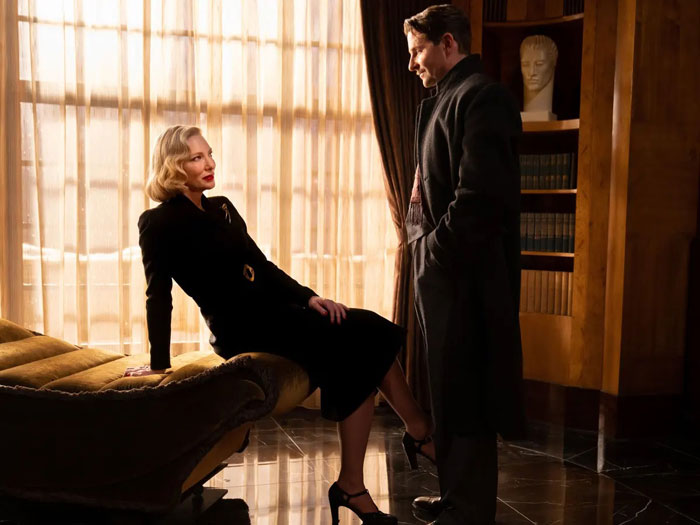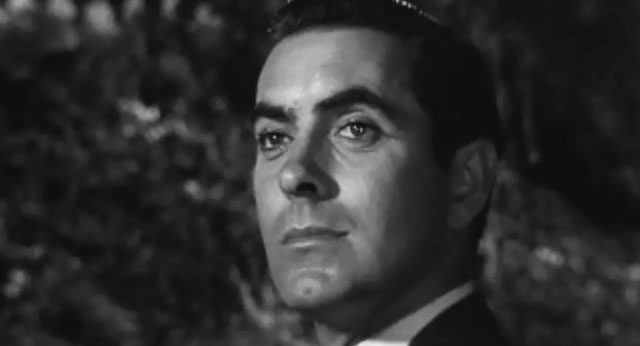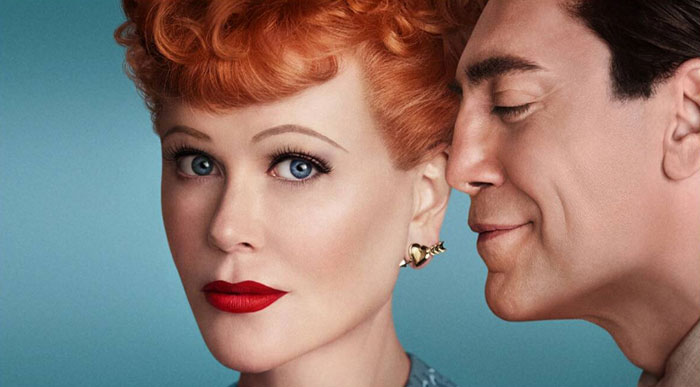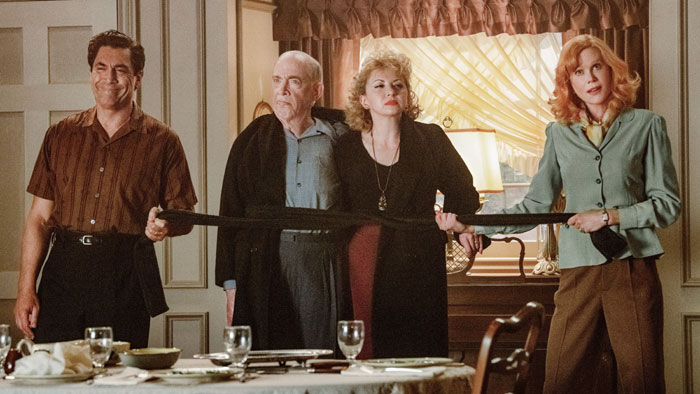|
Two recently Oscar-nominated films are essentially reconsiderations of American popular culture
circa 1950. Guillermo del Toro's Nightmare Alley, on HBO Max,is a remake of Edmund Goulding's 1947 film noir, which portrayed the seamiest aspects of traveling carnivals. Aaron Sorkin's Being the Ricardos, on
Amazon Prime, is a backstage drama about the stars of arguably the most popular television series ever, I Love Lucy, during the most perilous week of their
lives. Both films are worth seeing, but with caveats.
Based on the 1946 novel by William Lindsay Gresham, the two film versions of Nightmare Alley present a fascinating case study
in how differently the same source material can be presented on screen. The basic story of both films is the same, portraying the rise and fall of Stanton Carlisle
(played by Tyrone Power in the earlier version and Bradley Cooper in the later), a carnival barker and con man who steals a special code from phony psychic Zeena (Joan
Blondell, Toni Collette) to become a headlining nightclub mentalist.
While Del Toro's version tracks Goulding's closely in terms of story, it is strikingly different in its visual style, its emphasis,
and its delineation of Carlisle. The character of the "geek"—a performer on the lowest rung of carnivals who bites the heads off live chickens in exchange for
alcohol—is illustrative. In Goulding's film, we see a barker—after extolling the depravity of the geek to the gaping crowd—toss the geek a chicken;
we see nothing but the crowd and hear nothing but its gasps of horror. Del Toro shows the geek biting into the chicken's neck.
This goes beyond even the greater freedom modern-day directors have in portraying violence and gore, into questions of directorial
sensibility. Goulding's film, with a screenplay by Jules Furthman and superb black-and-white photography by Lee Garmes, is a textbook example of a film noir nightmare, Garmes'
camera leading Carlisle and the audience through a Stygian labyrinth of lies, false hopes, and menace.
In contrast. Del Toro's Nightmare Alley, written by Del Toro and Kim Morgan with photography by Del Toro's usual cameraman Dan
Laustsen, is a nightmare of a more lurid sort. In Nightmare Alley, Del Toro employs a heightened visual palette, as he did in Pan's Labyrinth and The
Shape of Water. Funhouse colors pervade the film so that even the office of psychiatrist Lilith Ritter (Cate Blanchett) and the mansion of sinister tycoon Ezra
Grindle (Richard Jenkins) seem to be part of the carnival. Everything seems distorted, nothing seems real, nothing can be trusted.

There are notable differences in the character of Carlisle between the two
films, both as written and as played. Carlisle is a trickster in both versions, but Cooper's Carlisle is less a victim of fate than Power's. Power's Carlisle
never got a break in life, and he is betrayed by almost everyone he meets—the con man who gets conned. Zeena's tarot deck, the Hanged Man
card keeping Carlisle in its snare, is the metaphor for Carlisle's trajectory. Cooper's Carlisle—without going into detail—is more of a criminal, less
sympathetic, and more the agent of his own destruction. The monstrous Cyclops baby--kept in a pickling jar like the other carnival freaks, its gaze
steady and pitiless--is the metaphor for Cooper's Carlisle. The end is bleak for Carlisle in both films, but in Del Toro's it is more like a sentence passed
on a condemned man.

I prefer the Goulding version, not just because I favor film noir. Del Toro's
film, forty minutes longer than Goulding's, feels padded by comparison. It also feels like overkill, especially in its portrayal of Lilith Ritter, who
virtually has FEMME FATALE emblazoned on her forehead. (This is more Del Toro's fault than Blanchett's.) Nevertheless, Del Toro's film is often
thrilling, as is its cast. My favorite in the cast, besides Cooper, is David Strathairn as Zeena's husband Pete—a former star mentalist who has
become a pitiful alcoholic. Strathairn brings a touching, mournful dignity to his scenes.
Being the Ricardos is by definition lighter than Nightmare Alley, though it
does not find its protagonists in a happy place. Written and directed by Sorkin, the film takes place over one week in 1952, during the filming of
the thirty-seventh episode of I Love Lucy. The series is resoundingly popular, but Lucille Ball (Nicole Kidman) and Desi Arnaz (Javier Bardem)
feel increasingly unsure of how much longer they can stay on the air. Lucy has just discovered she's pregnant with the child who would be Desi Jr.,
and Lucy and Desi want the pregnancy written into the show. That is much against the will of producer Jess Oppenheimer (Tony Hale), who shudders
at the thought of what audiences and sponsors would think of an actress—even a respectably married one—who has obviously had sex.

Desi makes most of the creative and business decisions for the show, and
Lucy wants Desi to receive an executive producer's credit—again much against Oppenheimer's will. There is the usual bickering between William
Frawley (J.K. Simmons) and Vivian Vance (Nina Arianda), who disliked each other from the start, as well as increasing ill will between Vance and
Lucy, who is starting to see Vance as a rival. Furthermore, Desi fails to come home most nights, and Lucy wants to know where he's going.
None of this necessarily spells death to I Love Lucy, but something else
might: at the end of his broadcast one night, Walter Winchell identifies Lucy as a Communist. In 1952, the blacklist reigns over Hollywood, and
Winchell's accusation could end Lucy's career.
Being the Ricardos telescopes a lot of events but is generally accurate as to
facts, as Ben Mankiewicz's recent ten-part podcast on Lucy and Desi confirms. It's too bad the script's accuracy doesn't ensure a better film. Being the Ricardos is entertaining, but it feels oddly generic. Part of the
problem is with its stars. Nicole Kidman and Javier Bardem are two of the strongest screen performers working today—too strong, alas, to lose
themselves in these idiosyncratic roles. Kidman does a good job of replicating Lucy's distinctive speaking voice, but she doesn't suggest Lucy
in any other way. Bardem sings well and cuts a commanding figure in front of an orchestra, but his voice is notably lower than Desi's, and he lacks
Desi's boyish elegance. Kidman and Bardem make a sexy couple, and they are brilliant at portraying two ambitious, high-powered stars who love each
other but are often at loggerheads. Nevertheless, they are not Lucy and Desi.

Worst of all, the excerpts Sorkin shows from the episode of I Love Lucy are
not funny, except for one brief scene in which a battling Fred and Ethel elbow each other off their chairs. I don't know whether to blame Sorkin,
Kidman, Bardem or all three, but although the backstage dialogue has Sorkin's trademark snap, the show-within-a-show is dullsville.
Being the Ricardos is an honorable attempt to pay homage to one of the
greatest sitcoms of all time and the comic geniuses who made it. It is mostly fun to watch, but it misses its mark.
|